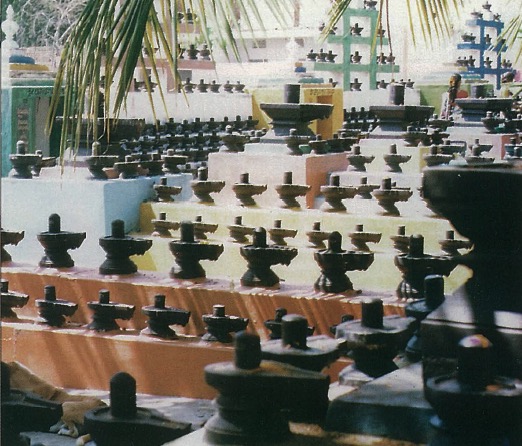BY CHOODIE SHIVARAM, BANGALORE
Kammasandra was just an obscure town 100 km from Bangalore until Sri Samba Shivamurthy Swamiji decided to propagate the greatness of Siva through the consecration of many Sivalingas dedicated to world peace and the welfare of Bharat. When I visited the town, now called Kotilingeswara, “City of Ten Million Icons,” all I could see were rows and rows of Sivalingas ranging in size from a few inches to a 108-foot Linga-shaped building. Over 500 devotees were present, many performing the ritual of prathishthapana, installation of a Sivalinga, with a priest’s assistance.
Sivalinga means “mark or sign, of Siva.” It is one of India’s most prevalent and highly revered temple icons, a rounded, elliptical, aniconic image usually set on a circular base, or pitha. It is the simplest and most ancient symbol of Siva, especially of Parasiva, Reality beyond all forms and qualities.
The temple complex is situated on 20 acres of land. Besides the 108-foot-tall Sivalinga and a 12-foot-tall Vrishabeshwara, shrines fill the area for Sri Manjunatheshwara, Trimurthi, Ashta-Lakshmi, Subramanya, the Navagrahas and many other Deities. The main attraction is the entrance from the highway to the central courtyard. The cylindrical icons line the colonnade, perch upon rooftops and stand as sentries around every shrine and building. In some places they are packed so tightly that one cannot walk between them. Most are traditional in shape; others have square bases. One is uniquely five-sided with five spouts.
“Koti” means 10 million. That’s the goal. So far, 3.5 million icons have been placed here by devotees fulfilling a vow or seeking a boon. Pilgrims seeking the blessings of installing an icon can do so for a fee. Acharyas and politicians alike (including late Prime Minister Rajiv Gandhi) have done so.
Kammasandra is mentioned in the Ramayana as a village Rama’s horse blessed as it wandered the land during the Ashwamedha Yajna [horse sacrifice]. People believe the oppulent Kolar gold fields nearby are the result. The area is also cited in the Puranas as a place where a fabulous ceremony was performed by Dakshabrahma.
